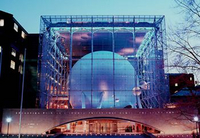|
|
|
|
|
|
Integral Field Spectrograph Optical Design |
|
As shown in the previous section, the image formed by the diffraction-limited coronagraph suffers from wavelength dependent speckles. The aim of the Integral Field Spectrograph (IFS) is to take the image plane of the coronograph, and form a spectrum for every pixel in this image plane. The coronagraph image plane is divided up using a grid of lenslets, which act as spatial filters forming a grid of pupil images.
For each lenslet, the beam diverges after these pupil images, where it is then collimated, then dispersed by passing through a prism, then refocussed onto the detector.
The optical design for the IFS was developed by Dave King. It consists of:

The optical design was modelled using the Zemax optical design software. The complete optical train will be built into a cryogenic enclosure, cooled to 78K (-195 degrees Centigrade). The effects of the thermal contraction are taken into account in the optical design.
A powerpoint presentation of the optical design is available here
Created by David King on 29 January, 2007

